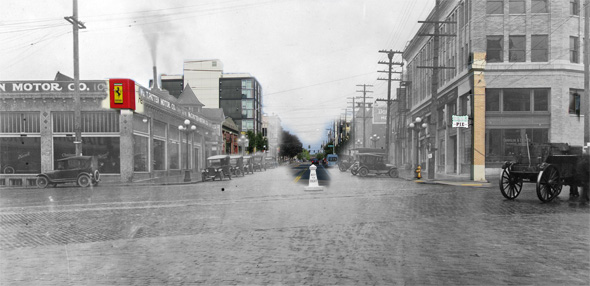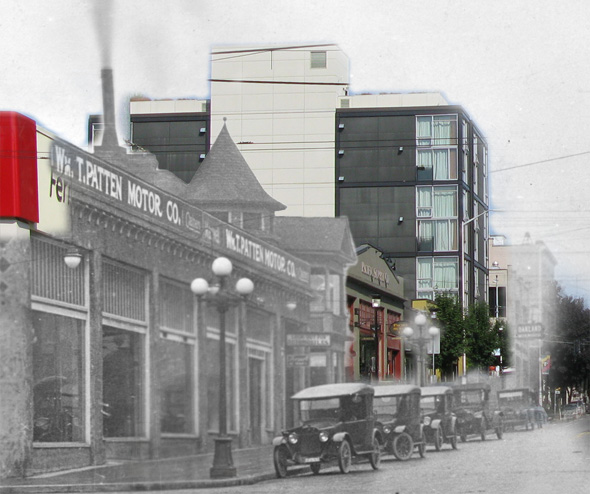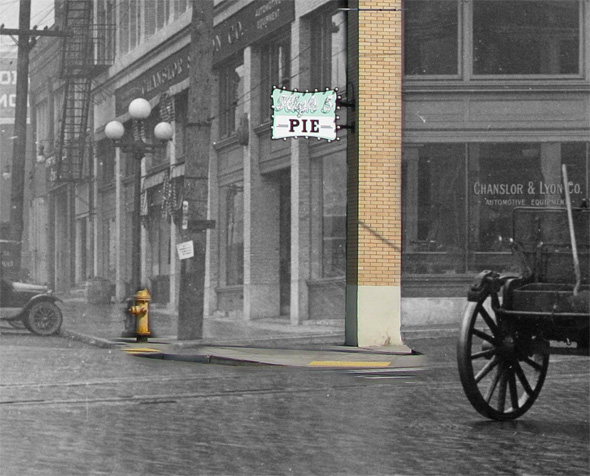 12th Ave Regraded, 1920 with pieces of 2012 (Images: Rob Ketcherside)
12th Ave Regraded, 1920 with pieces of 2012 (Images: Rob Ketcherside)
Righteous indignation has a long history in Seattle. More than 100 years ago, the Eleventh Avenue Improvement Club got pissed off at City Engineer R. H. Thomson‘s plan to regrade Capitol Hill. In 1908, he wanted to flatten out 12th Avenue from Jackson to Aloha, providing new access to Capitol Hill from Pioneer Square.
Before we dig into the regrade, how about a quick survey of the landscape here looking north from Madison on 12th.
Captain William T. Patten‘s auto dealership is on the left of the 1920 photograph. The buiding dates to 1913, just after the regrade was completed. Today it’s Ferrari of Seattle, and it was Lee Moran‘s Lincoln dealership in 1957 as featured recently in CHS Re:Take. In an amazing coincidence, Patten’s store manager a few years earlier, Arthur Dawson, was working in 1920 down at Greater Motors in the Utrecht building as featured in CHS Re:Take last time. Of course if you’re convinced that auto row was a tightly linked social network, it doesn’t seem like such a coincidence.
Just next to Patten’s was a Victorian home later displaced for an extension of the Ferrari building. In 1920 it already looked out of place, a memory of the neighborhood before 1910’s 12th Avenue regrade. Further down on the other side of the street is another turreted building. That’s the landmark-aborted 1200 East Pike, still there today.
 Demolished Victorian home behind William Patten Motors (1920). In front of Pacific Supply (2012).
Demolished Victorian home behind William Patten Motors (1920). In front of Pacific Supply (2012).
On the far right was Chanslor & Lyon, one of the many automotive related businesses that supplemented the dealers. Chanslor & Lyon started in San Francisco, entering the Seattle market in 1908 by buying out Platt Automobile Supply in Belltown. They moved to their new building here in early 1920, just a few months before the photograph. Today, of course, this is Trace Lofts with High 5 Pie and other contributions to the 12th Avenue foodie network.
 High 5 Pie and Chanslor & Lyon Automotive Equipment
High 5 Pie and Chanslor & Lyon Automotive Equipment
In the foreground, the bricked, level street was a decade old. Back in 1908, the neighborhood, represented by the Eleventh Avenue Improvement Club, was not interested in raising this intersection 12 feet.
So what did they want? A tunnel. Until the Alaskan Way Viaduct replacement project, everyone loved tunnels in Seattle.
Their counter-proposal was a tunnel under Union Street from Broadway to what’s now Freeway Park over I-5. It would connect Broadway and the backside of First Hill with the growing commercial district around 5th and Union. Obviously they lost. But they almost got both.
After Thomson moved to Capitol Hill in 1909, he came to agree with them. Although the regrade was already underway, Thomson ghost-wrote* into the 1911 Plan of Seattle:
The ever-increasing traffic around the north end of First Hill over Pike and Pine Streets clearly points to a time when travel will be seriously congested, and this, with no opportunity for opening up additional streets with as favorable grades, justifies the belief that a tunnel route for teams will become an economic necessity in the comparatively near future. The most favorable route for such a tunnel is from the intersection of Ninth Avenue and Union Street to the intersection of East Spring Street and Eleventh Avenue.
 Twelfth from Union and Madison, 1920 (Courtesy Seattle Municipal Archives)
Twelfth from Union and Madison, 1920 (Courtesy Seattle Municipal Archives)
It didn’t happen in 1911 and tunnel discussion died for awhile. It came back in the Roaring 20’s, with plans even being drawn up and several attempts to secure funding and support continued until 1930. The Union Street Tunnel was brought up again during World War Two, when the city council amazingly asked the Army to build it as a giant air raid shelter.
12th Avenue is not the sexiest regrade. It didn’t make it to HistoryLink’s profile of Thomson or Wikipedia’s summary of that profile. It got a whole sentence in the 1978 book Public Works in Seattle. Partly there were just too many regrades to list. Also, 12th Avenue ruins the entire regrade image — no hill was knocked down. But it was significant as the last regrade that Thomson executed before leaving city government in 1911. By that point Seattle had more dirt than it knew what to do with. So, he joined the newly-formed Port of Seattle, which was busy building islands.
* I may be alone in thinking R. H. Thomson “suggested” much of the Plan of Seattle to his good friend and out-of-towner Virgil Bogue.
In case you missed them, here are the last few Re:Takes on CHS:
- The social network of Capitol Hill’s Auto Row, 1921 and 2012
- Life at 12th and Union, 1957 and 2011
- Berlin Bakery Beatdown at 9th and James, 1905 and 2011
Local history expert Rob Ketcherside shares his vision of the p
ast and present with his Re:Take series of works on CHS and other Seattle sites.



Thank you, Robert, for your extremely interesting and informative restrospectives of our neighborhood!
I aways come away from these posts dreaming about what could have been, but this one more than ever.
Really? You think a Capitol Hill tunnel would have been a good idea?
Thank you both for your comments.
Perhaps hybridtoaster’s sentiment is… if not for the automobile, we could all be living in Victorian boarding houses, and commute to work by horse and buggy through an unventilated tunnel that smells like Yakima? ;)
(The tunnel was first proposed, as far as I can tell, in 1903, when there were only a few cars in Seattle)
Deeply appreciate the support. “Interesting and informative” is exactly my target!
What were the topographic characteristics before the 12th ave regrade? and where did the material go? Was the goal to reduce the grade from the southern end of 12th all the way to aloha? was this just a steep grade? or was it variable all along the way? and did the graded material get used to fill things in on either side? or was it moved significantly and used in other projects?
12th Avenue was at the bottom of a valley, which today looks to us like a flat plain between First Hill and Second/Renton/”Cherry” Hill. We’ll hear more about the Pike-Madison area before the regrade in an upcoming Re:Take.
The general characteristic of the regrade was cutting at the south and filling at the north. Think of the steep drop from Washington to Yesler on the west side of Boren. Boren was cut through much later, so 12th Ave regrade would be the first time that the ridge would be assaulted. The rest was fill, to the tune of 343,000 cubic yards. The deepest fill was around here, from Spring to Pine.
They projected to take dirt from the Jackson regrade, cellars of nearby construction sites, and properties above grade in the area. I haven’t verified the actual source of fill.
Wonderful piece. Thank you for all the effort that went into this.
Thanks for the encouragement Allan!
Robert: These snapshots of our landscape here are so valuable. Thank you for doing these! I absolutely adore reading about the history and seeing these beautiful pics pieced together. I often think that if we had this perspective at every design review or neighborhood meeting it would be so very helpful. So that we could all understand that these types of neighborhood changing projects, big and small, have been happening since Seattle was born. (They tore down that Victorian on 12th for the auto dealership extension, THE HORROR!)
Thank you for providing this perspective and insight into our history here on Cap Hill.
If that Victorian was still standing, and there was a proposal today to demolish it, you can be sure there would be a huge outcry to save it…rightfully so! I wonder if there was any kind of protest back then?
This was one of the nicer houses on the block for sure.
It was destroyed in late 1927. I don’t notice any outcry in the Seattle Times, but that is just one media outlet. What they did have was a classified ad for the demolition:
“WRECKING apartment house: 100 complete windows, 60 5-panel doors, 200,000 feet 2×4, 2×6, 2×10, bathtubs, toilets and sinks.”
That’s what it takes to build a Victorian boarding house.
A couple of years earlier the building was up for sale:
“$400 — 11-room apartment house, rent $45; good income.”
@kgdlg: I am available for design review meetings, weddings and bar mitzvahs!
Robert I was half joking but kind of serious, your insight at these meetings, to offer a historical perspective, would be so helpful! I am not saying that change throughout history is a reason to knock everything down (I am staunchly for historic preservation on truly historic structures) but understanding that the neighborhood has always had change is so important.
And man, $400 bucks for that house? What a steal!
If you looked at the view directly to the south of where that photo was you would see 6 Robblees on the NE corner of 12th and Spring (one block to the south). My grandfather worked there starting in 1930 when they got the contract to install pneumatic (tubed) tires on the UPS fleet of delivery trucks. They were converted from solid rubber tires. They later moved down to 4th Ave S, and then Pacific Hwy South were they are today. At the time 6 Robblees worked on cars, trucks and bicyles.
Thanks, Brian. I’d love to hear more.